|
|
|
Sort Order |
|
|
|
Items / Page
|
|
|
|
|
|
|
| Srl | Item |
| 1 |
ID:
133403
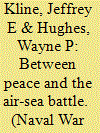

|
|
|
|
|
| Publication |
2012.
|
| Summary/Abstract |
Land-sea wars" have significant maritime dimensions, with command of the sea posited by this study as mattering more than either [land combat] skill or strength. . . . [C]ommand of the sea is a preeminent form of power that determines the outcome of land-sea conflicts.
JOHN ARQUILLA
In a February 2012 article published in the American Interest, General Norton A. Schwartz, Chief of Staffof the U.S. Air Force, and Admiral Jonathan W. Greenert, Chief of Naval Operations, provide solid justification for more closely integrating Air Force and Navy capabilities into an Air-Sea Battle strategy.1 We applaud the Air-Sea Battle component as the most effective means of preparing for the most challenging conflict-full-scale conventional war
|
|
|
|
|
|
|
|
|
|
|
|
|
|
|
|
| 2 |
ID:
133986
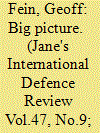

|
|
|
|
|
| Publication |
2014.
|
| Summary/Abstract |
In 2015 the USN will deploy the USS Theodore Roosevelt Strike group equipped with a new capability to improve battlespace situation awareness. Geoff Fein examines the measures taken to make NIFC-CA a reality.
|
|
|
|
|
|
|
|
|
|
|
|
|
|
|
|
| 3 |
ID:
133982
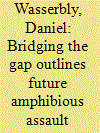

|
|
|
|
|
| Publication |
2014.
|
| Summary/Abstract |
The US Marine Corps, (USMC), is significantly overhauling its concepts for ship to shore manoeuvre and plans to start by buying personnel carriers with limited swimming abilities with limited swimming abilities and exploring a variety of connector craft.
|
|
|
|
|
|
|
|
|
|
|
|
|
|
|
|
| 4 |
ID:
133402
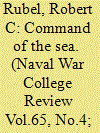

|
|
|
|
|
| Publication |
2012.
|
| Summary/Abstract |
the trade of the world commands the riches of the world and consequently the world itself. For in war . . . the common sense of some and the genius of others sees and properly applies means to ends; and naval strategy, like naval tactics, when boiled down, is simply the proper use of means to attain ends. But in peace, as in idleness, such matters drop out of mind, unless systematic provision is made for keeping them in view.
The last great sea battle occurred in 1944. Since then the world ocean has been open to free navigation by all nations as a matter of American policy. The ability to enforce this policy-or perhaps better said, the absence of serious challenges to this policy-has been in significant part a product of the superiority of the U.S. Navy. Despite a latent and partial challenge during the Cold War by the Soviet navy, since World War II the degree and persistence of U.S. Navy superiority have led most people to take it for granted and have caused the old term "command of the sea" virtually to disappear from the naval lexicon.1 However,
the emergence of a powerful Chinese navy and an associated land-based seadenial force is stimulating a new focus on sea control and overcoming antiaccess/ area-denial efforts. New concepts, such as "AirSea Battle," are being developed and investments made in platforms, weapons, and systems. This activity is critical to American strategic interests and prospects, and it must be informed by an understanding of command of the sea as a foundational concept of sea power. A reconsideration of command of the sea is all the more necessary as political, economic, and technological developments have significantly changed the nature of how sea power influences the dynamics of geopolitical interactions. This article will argue for an extended definition of the term and its renewed application to naval strategy and doctrine.
|
|
|
|
|
|
|
|
|
|
|
|
|
|
|
|
| 5 |
ID:
133379
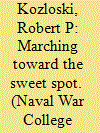

|
|
|
|
|
| Publication |
2013.
|
| Summary/Abstract |
Before leaving his position as Secretary of Defense in 2010, Robert Gates offered a wake-up call in a speech to the Marine Corps Association in 2010: "It [is] time to redefine the purpose and size of the Marine Corps." The perception even then was that the Marine Corps had become too big, too heavy, and too far removed from its maritime roots.1
|
|
|
|
|
|
|
|
|
|
|
|
|
|
|
|
| 6 |
ID:
133391
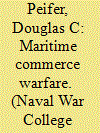

|
|
|
|
|
| Publication |
2013.
|
| Summary/Abstract |
Maritime commerce warfare" has a distinctly dated whiff. The great Anglo- American naval theorists of the late nineteenth and early twentieth centuries-the Colomb brothers, Alfred Thayer Mahan, and Julian Corbett-all dismissed it as an indecisive strategy of the weak. Imperial Germany's turn to unrestricted submarine warfare in 1917 failed to achieve its political purpose, instead bringing the United States into the war just as war weariness and revolution threatened to undermine the Entente's military effectiveness. In the Second World War, both Germany and the United States used the submarine with deadly effectiveness against the maritime supply lines of their enemies, but even the more effective of their campaigns-that of the U
|
|
|
|
|
|
|
|
|
|
|
|
|
|
|
|
| 7 |
ID:
133376
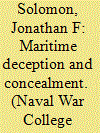

|
|
|
|
|
| Publication |
2014.
|
| Summary/Abstract |
Joint Operational Access Concept - JOAC
Post Cold War
United States - US
Us Navy - USN
Maritime Access
Overseas Region
Geopolitics
Warfare System
Warfare Domain
Maritime Surveillance
Reconnaissance Networks
Strategic Competitors
Reconnaissance-Strike Networks - RSN
|
|
|
|
|
|
|
|
|
|
|
|
|
|
|
|
| 8 |
ID:
133400
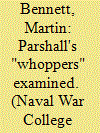

|
|
|
|
|
| Publication |
2013.
|
| Summary/Abstract |
This was written in response to an article by Jon Parshall that appeared in the Spring 2010 Naval War College Review.1 When I first came across Parshall's article I was interested and even intrigued, but the more I read, the more apparent it became that his work was not sound. One element, I believe, that may have colored what otherwise might have been an objective analysis was Parshall's clearly stated goal to "bury Fuchida." Generally, a biased, set conclusion is not a good starting point for a historical analysis. Good research begins with questions and ends with conclusions, when facts permit. Parshall attempts to make the facts fit his conclusions, and when he cannot, he uses conjecture and assumptions to try to bridge the gap. Throughout his article, Parshall employs a wide variety of euphemisms accusing Fuchida of "lies." One would expect a less snarky, cynical analysis from a historian.
|
|
|
|
|
|
|
|
|
|
|
|
|
|
|
|
| 9 |
ID:
133397
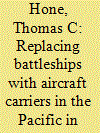

|
|
|
|
|
| Publication |
2013.
|
| Summary/Abstract |
The article discusses changes in U.S. Navy tactics and operations in the Pacific theater of World War II, which were characterized by the increased use of aircraft carriers. The author discusses the implementation of naval aviation programs in the organization prior to the onset of World War II, and argues that carriers were not used as outright replacements for battleships.
|
|
|
|
|
|
|
|
|
|
|
|
|
|
|
|
| 10 |
ID:
125884
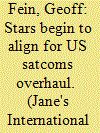

|
|
|
|
|
| Publication |
2013.
|
| Summary/Abstract |
The first of five planned US Navy (USN) mobile users objective system (MOUS) satellites, which will replace the ageing and heavily used UHF systems, has begun six months of technical and operational evaluation, leading to initial operational capabilities (IOC) in the June 2012 time frame.
|
|
|
|
|
|
|
|
|
|
|
|
|
|
|
|
| 11 |
ID:
133409
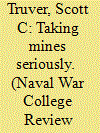

|
|
|
|
|
| Publication |
2012.
|
| Summary/Abstract |
A mine is a terrible thing that waits. The easy way is always mined. Any ship can be a minesweeper-once. Sea mines and the need to counter them have been constants for the U.S. Navy since the earliest days of the Republic. In January 1778, patriot David Bushnell used floating kegs of gunpowder fitted with contact firing mechanisms to attack a British fleet anchored in the Delaware River above Philadelphia. Four British sailors died trying to retrieve the kegs-an early example of the challenges of explosive ordnance disposal (EOD) against an unknown threat-but the ships were unscathed. Since that uncertain beginning, mines and mine countermeasures (MCM) have figured prominently in the Civil War, Spanish-American War, both world wars, Korea, Vietnam, numerous Cold War crises, and Operations DESERT STORM and IRAQI FREEDOM.
|
|
|
|
|
|
|
|
|
|
|
|
|
|
|
|
| 12 |
ID:
129181
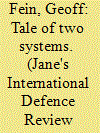

|
|
|
|
|
| Publication |
2014.
|
| Summary/Abstract |
In its fiscal year 2015 (FY 2015), budget, the US department of Defence (DoD) tasked the US navy (USN) with finding a replacement for the littoral combat ship (LCS) by the end of 2014. The new ship can be a new design or a modified version of LCS.
|
|
|
|
|
|
|
|
|
|
|
|
|
|
|
|
|
|
|
|
|